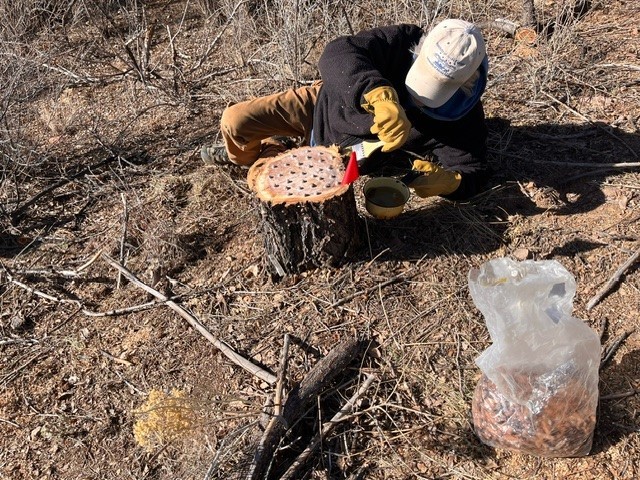 A pilot project to establish a protocol for Siberian Elm eradication using -fungal inoculants was concentrated on five discreet areas throughout the City: The Arroyo de los Pinos behind Camino Lado, the Arroyo de las Cruces near Frenchy's Field Park, the Sierra Del Norte Trail Head/Dog Park, SWAN Park, and the Santa Fe River Trail near the Gonzales Pedestrian Crossing.
A pilot project to establish a protocol for Siberian Elm eradication using -fungal inoculants was concentrated on five discreet areas throughout the City: The Arroyo de los Pinos behind Camino Lado, the Arroyo de las Cruces near Frenchy's Field Park, the Sierra Del Norte Trail Head/Dog Park, SWAN Park, and the Santa Fe River Trail near the Gonzales Pedestrian Crossing.
The project, led by Reese Baker of The Rain Catcher, LLC, is part of a research project piloted with the help of the City’s Parks and Open Space Division’s River and Watershed Section.
The project's goal is to find a natural, nontoxic treatment protocol for controlling highly invasive Siberian Elm. Freshly cut tree stumps were inoculated with a variety of mushroom species that would work to decay the tree's cellular makeup. Over time, the fungus will kill the supporting root system to prevent resprouting. The inoculated tree stumps will be monitored for three years to measure the efficacy of this treatment.
Neighboring trees will not be affected as these mushrooms are host-specific, benign to healthy trees, and do not spread. Spores from the fruiting body of a subsequent mushroom will not affect a healthy tree. The plugs used in this study are lab-grown and contain living mycelium that can colonize the freshly cut (injured) tree stump.
An FAQ with Baker:
How do the fungi kill the tree (be super basic)?
The fungal mycelium growing on the plugs moves into the tree's cambium. Since the tree has been freshly cut, its defense mechanisms are severely diminished, and the mycelium can now colonize the tree and use it as a food source.
What species are you using?
Pleurotus, Laetiporus, Pholiota, Phaeolus, Trametes and a control.
How many plugs per stump?
Plugs start in the center and go about 1.5-2” in a grid pattern. Then, two rows along the side through the bark are also about 1.5-2” apart.
Where do the plugs come from?
These plugs are grown at the UNM Biology labs and cultured from actual spores that we have collected in NM, so everything is native to NM.
Why don’t the mushrooms kill neighboring trees?
It would be virtually impossible to kill neighboring trees because the tree defenses are too strong when the tree is functioning normally. This is why we have to cut the trees down and immediately plug them with a massive amount of already growing mycelium. Spores would have no chance to colonize the tree, and if/when the fungi fruit, the spores are all that will come from the dead tree. Also, Trametes and Pluerotus are white rot fungi; they don’t usually kill trees. They only eat dead wood. Laetiporus is a brown rot fungus and only eats dead wood usually. Phaeolus and Pholiota are facultative pathogens that can kill trees or use them as food sources, but they are host-specific while growing.
